The papillomavirus E8-E2C protein represses DNA replication from extrachromosomal origins
- PMID: 14585992
- PMCID: PMC262328
- DOI: 10.1128/MCB.23.22.8352-8362.2003
The papillomavirus E8-E2C protein represses DNA replication from extrachromosomal origins
Abstract
Carcinogenic DNA viruses such as high-risk human papillomaviruses (HPV) and Epstein-Barr-Virus (EBV) replicate during persistent infections as low-copy-number plasmids. EBV DNA replication is restricted by host cell replication licensing mechanisms. In contrast, copy number control of HPV genomes is not under cellular control but involves the viral sequence-specific DNA-binding E2 activator and E8-E2C repressor proteins. Analysis of HPV31 mutant genomes revealed that residues outside of the DNA-binding/dimerization domain of E8-E2C limit viral DNA replication, indicating that binding site competition or heterodimerization among E2 and E8-E2C proteins does not contribute to copy number control. Domain swap experiments demonstrated that the amino-terminal 21 amino acids of E8-E2C represent a novel, transferable DNA replication repressor domain, whose activity requires conserved lysine and tryptophan residues. Furthermore, E8-E2C (1-21)-GAL4 fusion proteins inhibited the replication of the plasmid origin of replication of EBV, suggesting that E8-E2C functions as a general replication repressor of extrachromosomal origins. This finding could be important for the development of novel therapies against persistent DNA tumor virus infections.
Figures
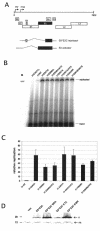
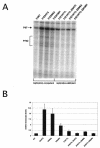
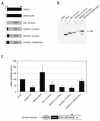
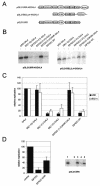
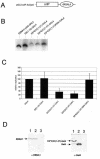
Similar articles
-
Interaction of NCOR/SMRT Repressor Complexes with Papillomavirus E8^E2C Proteins Inhibits Viral Replication.PLoS Pathog. 2016 Apr 11;12(4):e1005556. doi: 10.1371/journal.ppat.1005556. eCollection 2016 Apr. PLoS Pathog. 2016. PMID: 27064408 Free PMC article.
-
Functions of Papillomavirus E8^E2 Proteins in Tissue Culture and In Vivo.Viruses. 2022 May 2;14(5):953. doi: 10.3390/v14050953. Viruses. 2022. PMID: 35632695 Free PMC article. Review.
-
The E8E2C protein, a negative regulator of viral transcription and replication, is required for extrachromosomal maintenance of human papillomavirus type 31 in keratinocytes.J Virol. 2000 Feb;74(3):1178-86. doi: 10.1128/jvi.74.3.1178-1186.2000. J Virol. 2000. PMID: 10627528 Free PMC article.
-
The E8 repression domain can replace the E2 transactivation domain for growth inhibition of HeLa cells by papillomavirus E2 proteins.Int J Cancer. 2007 Nov 15;121(10):2284-92. doi: 10.1002/ijc.22907. Int J Cancer. 2007. PMID: 17583574
-
Control of viral replication and transcription by the papillomavirus E8^E2 protein.Virus Res. 2017 Mar 2;231:96-102. doi: 10.1016/j.virusres.2016.11.005. Epub 2016 Nov 4. Virus Res. 2017. PMID: 27825778 Review.
Cited by
-
Inhibition of transcription and DNA replication by the papillomavirus E8-E2C protein is mediated by interaction with corepressor molecules.J Virol. 2008 Jun;82(11):5127-36. doi: 10.1128/JVI.02647-07. Epub 2008 Mar 19. J Virol. 2008. PMID: 18353941 Free PMC article.
-
Initial amplification of the HPV18 genome proceeds via two distinct replication mechanisms.Sci Rep. 2015 Nov 2;5:15952. doi: 10.1038/srep15952. Sci Rep. 2015. PMID: 26522968 Free PMC article.
-
Interaction of NCOR/SMRT Repressor Complexes with Papillomavirus E8^E2C Proteins Inhibits Viral Replication.PLoS Pathog. 2016 Apr 11;12(4):e1005556. doi: 10.1371/journal.ppat.1005556. eCollection 2016 Apr. PLoS Pathog. 2016. PMID: 27064408 Free PMC article.
-
Functions of Papillomavirus E8^E2 Proteins in Tissue Culture and In Vivo.Viruses. 2022 May 2;14(5):953. doi: 10.3390/v14050953. Viruses. 2022. PMID: 35632695 Free PMC article. Review.
-
The molecular biology and HPV drug responsiveness of cynomolgus macaque papillomaviruses support their use in the development of a relevant in vivo model for antiviral drug testing.PLoS One. 2019 Jan 25;14(1):e0211235. doi: 10.1371/journal.pone.0211235. eCollection 2019. PLoS One. 2019. PMID: 30682126 Free PMC article.
References
Publication types
MeSH terms
Substances
LinkOut - more resources
Full Text Sources
